The Paradox of Renewable Energy
Two weeks ago, I had the wonderful opportunity to explore Iceland and learn about its unique energy policy through an 8-day Adventure Program on Renewable Energy and Sustainability offered through the GREEN Program. Although it was only eight days long, we were able to attend lectures from professors at the Iceland School of Energy in Reykjavik University, tour geothermal and hydropower plants, and see amazing landscapes as well.
The Appeal: Why renewable energy?
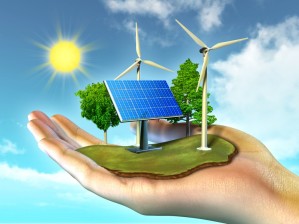
Before going on this trip, I had considered renewable energy to be a part of this utopian vision for an environmentally friendly future, with solar panels and wind turbines everywhere and all the plants, animals, and humans living in harmony. It may sound silly; however, having always heard of renewable energies in the context of climate change, they were and are often portrayed as a magic solution. They often come with a narrative that boasts about their potential to solve our world’s major problems, namely:
1. Saving the Environment: Renewables don’t pollute (as much).
Electricity production takes up the largest percentage of greenhouse gas emissions in the world. If we can switch our electricity production from fossil fuels (coal, natural gas, and petroleum) to renewables (solar, wind, geothermal, hydropower, etc.), we will be able to drastically reduce our carbon footprint and hopefully prevent or considerably slow climate change.
2. Securing our Energy Supply: Renewables are (theoretically) replenishable.
The current issue that the world is often scared to face is that fossil fuels and other nonrenewable sources of energy are finite. Like we learn after every oil shock, the world is extremely dependent on an ever depleting resource. This makes the idea of a source of energy that can be “renewed” infinitely or used without depletion quite alluring.
The Leader: Iceland
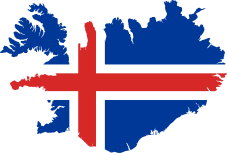
In 2014, 99.9% of Iceland’s electricity production came from renewable sources, a combination of geothermal and hydropower. Not to mention the 90% of geothermal energy which was used for space heating (heating up buildings/homes).
Despite being such a small country, Iceland stands out as a major leader in this sector, showing the world how to be resourceful with the geography and resources you have.
The Culture Shock
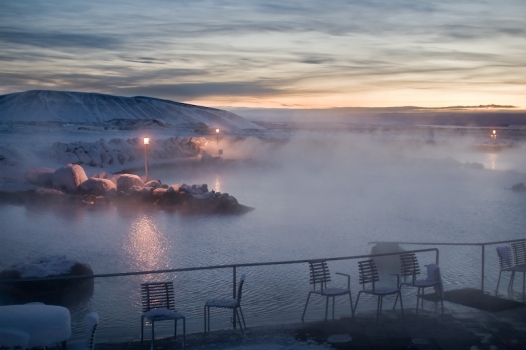
Needless to say, when I first learned about Iceland’s leadership with renewables, I was ecstatic. When I landed, I half-expected a land of progressive, climate conscious, environmentalists thriving in an area rich with renewable energy sources. I was in for a quite a shock.
Instead, what I saw was a culture of energy consumption. Everyone was driving oil-based vehicles. Swimming pools and outdoor hot tubs – with fresh water from the glaciers, heated using geothermal heat transfer – were a common tourist attraction that you could find almost everywhere. Highways were lit up with light posts every few feet, which even the taxi driver admitted was fairly excessive. Many of the roads in the city had pipes running geothermal-heated water underneath the pavement in order to melt the snow. While touring a geothermal plant, we learned that aluminum smelting factories, a very electricity-heavy industry, were flocking towards Iceland for its cheap energy costs. We visited one of several greenhouses that grow massive amounts of tomatoes, using electricity to power lights for the plants throughout the entire year, for twenty-four hours, every single day. Even in the university, rather than turning down the heat using a thermostat, the professors would simply open the window if it was getting too hot.
In this state of disbelief, I soon learned that while Iceland was a leader in the field of renewable energy, it was also a leader in energy consumption. With an energy use of 16,679 kg of oil equivalent per capita (as of 2013), Iceland has the highest amount of energy use per capita in the world – and by a long shot. According to the World Bank, Iceland’s runner-up, Luxembourg, lags behind at less than half the amount, with a mere 7,327 kg.
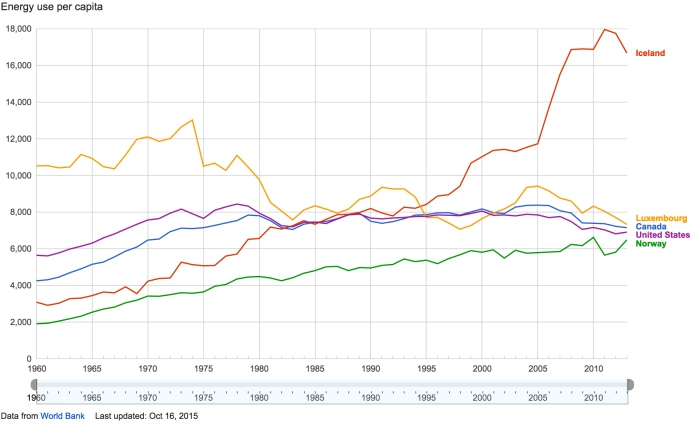
The Paradox: More Renewables = More Consumption?
After learning about Iceland’s energy use, my immediate response was – why is their energy consumption so high?
There are many ways to answer this question (check out this video), but from what I contemplated and learned, the core of the answer lies in the very reasons we love renewables to begin with:
1. Saving the Environment: Renewables don’t pollute (as much).
Translation: It’s “guilt-free.” To paraphrase my city tour guide, since all the electricity comes from renewables, you can use as much as you’d like! Go ahead, turn on the TV, take a trip to Spain, and come back a week later – no worries, no guilt – you’re not harming the environment.
2. Securing our Energy Supply: Renewables are (theoretically) replenishable.
Translation: It’s “infinite.” There’s no need to worry about using too much heat or water, we aren’t going to be losing our energy sources anytime soon.
Lesson #1: Renewable energy is not synonymous with sustainability.
The first thing that learning about this paradox helped me do was check my assumptions. I realized that, up until that point, I had always seen renewable energy as the “magic solution” which would become the sustainable future (remember the happy plants, animals, and humans living in harmony?). However, what I realize is that while any sustainable solution to our problems would almost definitely include renewable energy as a major part of it, producing renewable energy doesn’t necessarily mean that you have created a sustainable solution.
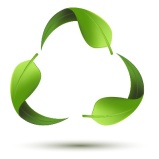
The way I see it, sustainability is a culture, a way of life, while renewable energy is a type of resource.
You can replace all of our fossil fuel-driven electricity plants with solar panels, wind turbines, biofuels, geothermal bore holes, and hydropower dams, and we can rejoice in the idea that we have plenty of clean energy that we can theoretically keep harnessing forever. However, what this ignores is the blatant environmental damage and unforeseen consequences that inevitably come with creating millions of solar panels, taking up miles of space to put up turbines, blocking the flow of rivers, and more. A switch to renewables alone is unable to create sustainability, or a way of life that would be able to support the planet and all of its beauty, inhabitants, and resources.
Lesson #2: We need to adjust our way of thinking.
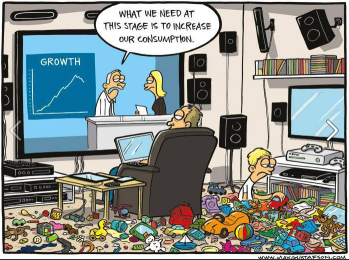
It is not enough to simply replace the role of nonrenewable energy with renewable energy. While it is a better alternative, renewables are not the complete solution – adjusting our culture of consumption can be. Yes, you can excuse this whole paradox of consumption by simply waving your hand and saying “it’s inevitable, it’s economics – supply and demand.” Sure, we are more likely to consume when we have more, and driven to conserve more when our resources are scarce.
However, it is the future and well-being of our planet that is at stake! If we want a better future, we must adjust our thinking and work to change our consumption. Simply because we can produce so much energy does not mean we should. And simply because we have more energy does not mean we need to use more of it.
We need to take a step back and understand that there is more to our problem than simply clean energy production. We can perfect the entire energy production process, and yet, that overlooks the entire waste process and the multitude of other side effects that come with our consumption.

For example, the aluminum smelting industry, a major consumer of electricity in Iceland, has started showing signs of fluoride pollution in surrounding areas. In the United States, high water consumption combined with droughts are placing more stress upon our water supply and treatment systems. The more we consume, the more we waste, the more mess we make, and inevitably, the more problems we face. Therefore, we have all the more reason to focus on reducing our individual consumption whether or not our resources are seemingly abundant in the short-term.
Conclusion?
While it is important to be creative and innovative in the way we approach the environmental problems of our time, one should be weary of solutions that are too narrowly-focused. Renewable energy is a promising answer to a specific question, but only a part of a much-needed multifaceted solution.
Many of our environmental issues are deeply rooted in a culture of consumption that often arises when we are presented with periods of abundance. At the end of the day, even with the best technological solutions, we are the ones who can make a huge difference by curbing our consumption on all levels. Either we can choose to adapt and shift this culture – or Nature will choose for us.
Subscribe now to get future posts in your inbox!
Intellectual Travels climate change conservation consumption culture energy environment Europe fossil fuels geothermal global warming Green GREEN Program hydropower Iceland paradox philosophy psychology Reykjavik University Study Abroad sustainability
Suraj Sehgal View All →
I am a student, a traveler, an activist, a meditation instructor…. and a blogger!
Come join me on my journey.

This is a well-composed summary of the reality of renewable energy.
Iceland’s unique geographical situation seems to explain its low threshold for climate change alertness. (Reference article: http://www.npr.org/templates/story/story.php?storyId=16859927) While I am not a fan of renewable energy partly because I feel skeptic toward some of the marketing strategies, I realize that “hyping up” the emerging technology is necessary. Just as materials science (my college major) department recruits students with tantalizing languages about the field’s possibility, renewable energy institute seems to need extra energy input to get public attention hence public support.
After reading your article, your focus on paradox helped me fish out this question (more of a doubt) I have:
By “relieving” people with an idea about alternative green technology, are we encouraging more consumption? In other words, are we focusing too much on advancing green technology and procrastinating to raise public appreciation for the social/technical challenges in implementing green technology? Yes, humans are capable of researching and developing more environmental friendly methods of doing what we have been doing. However, community seems to lack the incentive to learn that green technology doesn’t work like how electronic technology works ( Image of new iPhone 6 advertisement pops up into my head).
Human behaviors are difficult to alter especially when our current materialistic culture is already established. Having to make this poor observation about human will is deplorable. Iceland community surely shows contradiction to the view that humans are stubborn to their acquired lifestyle. Thanks for sharing your experience in Iceland. Let’s hope for a more proactive year 2016!
LikeLike
Very thoughtful piece Suraj!
LikeLiked by 1 person
Very well written Suraj.
LikeLiked by 1 person
Great article Suraj. It was a fun read.
IMO it’s hard to make people care about things that are not directly affecting their day to day life. This is always going to be one of the biggest problems in battling the green war.
P. S. Always put a source on all images in your posts. Try to re-host most of them because you never know what will happen to the original.
LikeLiked by 1 person
Thank you! I’m glad you liked it.
Also – point noted regarding sourcing and hosting. In more recent articles I’ve tried to stick with more photos that are open license or personally taken.
LikeLike